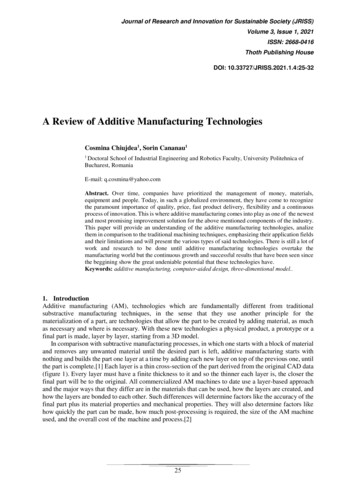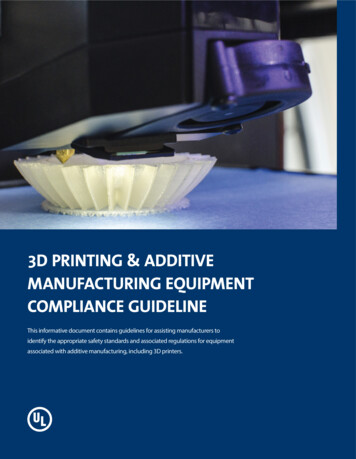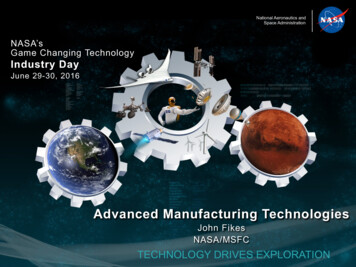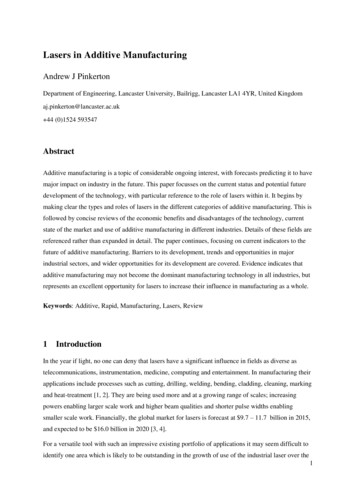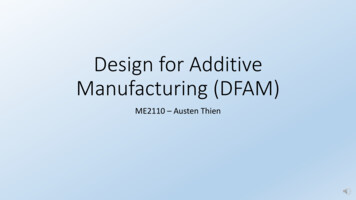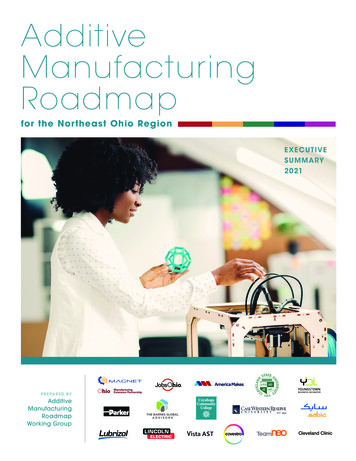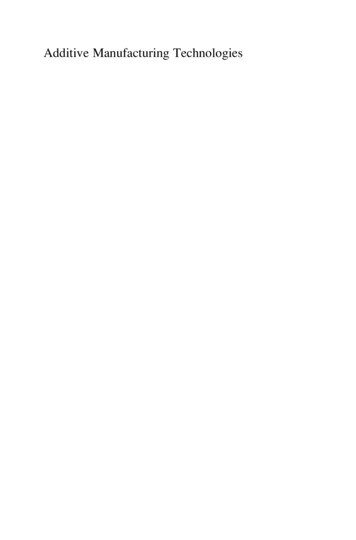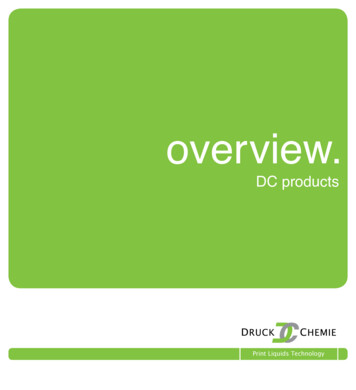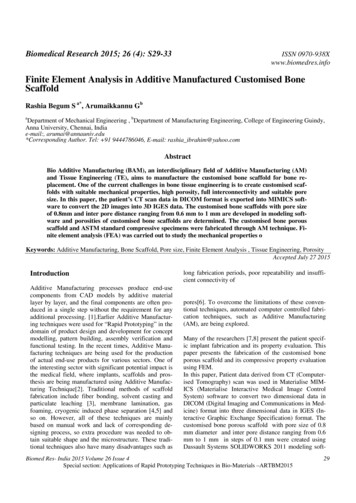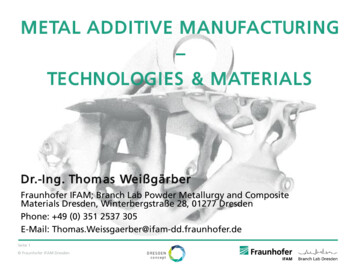
Transcription
METAL ADDITIVE MANUFACTURING–TECHNOLOGIES & MATERIALSDr.-Ing. Thom as WeißgärberFraunhofer IFAM; Branch Lab Powder Metallurgy and CompositeMaterials Dresden, Winterbergstraße 28, 01277 DresdenPhone: 49 (0) 351 2537 305E-Mail: Thomas.Weissgaerber@ifam-dd.fraunhofer.deSeite 1 Fraunhofer IFAM Dresden
Outline0. Introduction Fraunhofer / IFAM1. Introduction AM Technologies2. Metal AM – Technologies2.1Overview2.2Melting Technologies2.2.1Electron Beam Free Form Fabrication (EBFF)2.2.2Direct Metal Deposition (Laser)2.2.3Laser Beam Melting (LBM)2.2.4Electron Beam Melting (EBM)Seite 2 Fraunhofer IFAM Dresden
Outline2. Metal AM – Technologies2.3Solid State Technologies2.3.1Introduction2.3.2Material Jetting2.3.3Binder Jetting2.3.4Fused Filament Fabrication (FFF)2.3.53d Screen Printing2.3.6Sheet LaminationSeite 3 Fraunhofer IFAM Dresden
nbergSt. AugustinAachenEuskirchenDarmstadtSt. ürnbergFreising Fraunhofer IFAM Dresden24.000 employeesDresdenStuttgartEfringenKirchen LeipzigSaarbrücken KarlsruhePfinztalFreiburg67 Fraunhofer institutes andindependent research units inGermanyJenaWürzburgKaiserslautern MünchenHolzkirchen 10 institutes or branches inDresden 4 of these at the Fraunhofer InstituteCenter Dresden
Fraunhofer IFAM: Branch Lab DresdenPermanent staff74Student employees35Budget7,8 Mio. Industry32 %Projects60 %Public fundingInvestmentsArea(Budget 2017) Fraunhofer IFAM Dresden8%0,7 Mio. 2850 m2Head of IFAM Dresden(prov. from 01/04/19):Dr.-Ing. Thomas Weißgärber
Profile of Fraunhofer IFAM DresdenFields of competenceSintered and Composite MaterialsCellular Metallic htweightMaterialsTribology3D MetalPrinting3D WireStructuresPorousMetalPaperTherm oelectricsThermalManagementHydrogen TechnologyElektrolysis Fraunhofer IFAM and corrosionresistantMaterialsEnergy und Thermal nAnalysis
SEBM competence @ IFAM DresdenPowder Accredited lab forcharacterization Assessment of newpowder analytics Fraunhofer IFAM DresdenDesign Design rules„Design for AM“, e.g.topology optimizationProcess Processdevelopment New materials Prototypes andComponents
0.Introduction Fraunhofer / IFAM Fraunhofer IFAM Dresden
1.Introduction AM TechnologiesAdditive Manufacturing: DefinitionIt is defined as the proces s of joining m aterials tom ake objects from 3D m odel data, usually lay erupon lay er, as opposed to subtractive manufacturingmethodologies. Synonyms are additive fabrication,additive processes, additive techniques, additive layermanufacturing, layer manufacturing, and freeformfabrication.Seite 9 Fraunhofer IFAM Dresden
1.Introduction AM TechnologiesSeite 10 Fraunhofer IFAM Dresden
IntroductionMetal Additiv e Manufacturing at Fraunhofer IFAM Las er Beam Melting(LBM) [HB] Electron BeamMelting (EBM) [DD]3D Metal Printing Binder Jetting approach(3DP) [HB] Seite 11 Fraunhofer IFAM Dresden 3D Metal Printing Binder Jetting approach(3DP) [HB]3D Metal Printing S creen Printing approach(3DMP) [DD]
2.METAL AM / Fraunhofer IFAM Dresden
2.METAL AM / Fraunhofer IFAM Dresden
2.METAL AM TECHNOLOGIES2.2MELTING TECHNOLOGIESComparison between different AM TechnologiesPow der Bedlas er beame - beamlas erPart complexityAccuracyPart sizeBuild rateMaterial varietyMaterial qualitySeite 14 Fraunhofer IFAM Dresdene - beamPow der Feedlas er beamlas erWire Feedlas er beame - beamplas m alas ere - beam
METAL AM TECHNOLOGIES2.2.1 Electron Beam Free Form Fabrication (EBFF)Part Dimensions:Diameter up to 40cmSelected Parameters:Length / Width app. 60cmWire diameter: 2,36mm (TiAl6V4)Built Rate: 2,3kg/hWire feeding:50% Material Savingcompared with machining1780mm/minWall Thicknesses: bis zu 0,76mm möglichSciaky, Inc. Fraunhofer IFAM Dresden
METAL AM TECHNOLOGIES2.2.3 Las er Beam Melting (LBM)Source: Fraunhofer-IWU Fraunhofer IFAM Dresden
METAL AM TECHNOLOGIES2.2.4 Electron Beam Melting (EBM) EBM is a hot proces s each layer of powder is pre-heated, temperature is materialdependent (e.g. Ti-6Al-4V: ca. 700 C, TiAl: 1000 C) powder “smoke” due to local buildup of charge is prevented byslight sintering of powder particles thermal stresses can be minimized EBM us es high v acuum as proces s atm os phere this is required in order for the electron beam to work highly reactive materials can be processed outgassing of impurities thermal insulationSeite 17 Fraunhofer IFAM Dresden
METAL AM TECHNOLOGIES (Electron Beam Melting (EBM))Construction of an tron-beam-melting/hardware/Seite 18 Fraunhofer IFAM Dresden
METAL AM TECHNOLOGIES (Electron Beam Melting (EBM))Methods of the powder evaluationpropertyParticle size distributionHall Flow/Gustavsson (time)normDIN 13320DIN ISO 4490/DIN EN ISO13517Morphology (SEM)relev anceFlowability (powder feed and raking)FlowabilityLayer homogeneityFlowability (powder feed and raking)Apparent densityDIN ISO 3923/DIN ISO3953Layer homogeneityImpuritiesDIN EN ISO 9556 (C, S)DIN ISO 4491 (O, N)Contamination before & after process,Component quality and propertiesMoisture measurement(TGA)Flowability (powder feed and raking)Component quality (internal faults)Composition (ICP-OES,carrier gas hot extraction)Component quality and propertiesPowder densitySeite 19 Fraunhofer IFAM DresdenDIN 51 913Component quality (internal faults)
METAL AM TECHNOLOGIES (Electron Beam Melting (EBM))Powder properties: comparison LBM - EBMPowderD10µmD50µmD90µmFlowabilitysg/cm³Bulk densityApparentg/cm³densityAl- proportion%V- proportion%Fe- proportion%O- proportion%N- proportion%Seite 20 Fraunhofer IFAM 815.753.970.210.1160.017LBM:differences in particle size( 8 µm)differences in flowability(32 – 53s)EBM:low Al content (at lowerlimit but withinspecifiaction)low Oxygen content
METAL AM TECHNOLOGIES (Electron Beam Melting (EBM))Powder properties, surplus powder EBMd10d50d90µmµmµmHall-Flow (2.5 m m )sRohdichteg/cm³ONm%m%new13 build 0,0170,140,018 slight increase of oxygen content better flowability all other properties remain constantSeite 21 Fraunhofer IFAM Dresden
METAL AM TECHNOLOGIES (Electron Beam Melting (EBM))Pre-heatingGeneral principles Strongly de-focussed beam is led above the area Due to the thermal energy introduced: formation of sinter necks between thepowder particles (diffusion) The process step is necessary because of the process stabilityElectron beam is interacting with the powder Charge concentration in particles leads to rejection „smoke“2 steps Preheating 1 Preheating 2Source: Arcam Seite 22 Fraunhofer IFAM Dresden
METAL AM TECHNOLOGIES (Electron Beam Melting (EBM))MeltingProcessing and properties of Ti-6Al-4VProcess development - influence of scan-speed (I constant) v low Very uneven surface, dents too much powder hasmolten Density 100% possible evaporating of Al v high Uneven surface Density 100% inner PorositySeite 23 Fraunhofer IFAM Dresdenlowvhigh
METAL AM TECHNOLOGIES (Electron Beam Melting (EBM))MeltingProcessing and properties of Ti-6Al-4VProcess development - influence of scan-speed (I constant) v low m edium : v low /m edium high:lowgrain refiningporosity ( construction errors),martensite formationmediumscan-speedSeite 24 Fraunhofer IFAM Dresdenhigh
METAL AM TECHNOLOGIES (Electron Beam Melting (EBM))Melting – increasing productivity300 J/m200 J/m100 J/mArcam Standard (80 cm³/h)25max. build rate (ca. 120 cm³/h)beam current [mA]201510good qualitysurface swellingrippled surfaceporosity50051015scan speed [m/s] without the need to change machine and powder, respectively: factorof 1,5 in build rate is possible Fraunhofer IFAM Dresden
METAL AM TECHNOLOGIES (Electron Beam Melting (EBM))Design rules for EBMDes ign lim its for s m all s tructures geometry demonstrator (available from RTC Duisburg) Fraunhofer IFAM Dresden
Design rules for EBMDes ign lim its for s m all s tructuresex am ple (I) – cy linders (Ti6Al4V; A2X) Minimum diameter: 0.6 mm systematic offset for d 0.6 mm: 0.15 – 0.2 mm21,81,61,4mm1,2Soll-Ø1Scan EBM10,8Scan EBM20,6CT EBM1CT EBM20,40,2021,751,51,2510,90,80,7mm Fraunhofer IFAM Dresden0,60,50,40,30,20,1
Design rules for EBMDes ign lim its for s m all s tructuresex am ple (I) – w alls (s traight) (Ti6Al4V; A2X) minimum wall thickness 0.6 mm systematic offset for d 0.6 mm: up to 0.2 mm21,81,61,4mm1,2Soll-Dicke1x-Richtung EBM10,8y-Richtung EBM1x-Richtung EBM20,6y-Richtung EBM20,40,2021,751,51,2510,90,80,7mm Fraunhofer IFAM Dresden0,60,50,40,30,20,1
METAL AM TECHNOLOGIES (Electron Beam Melting (EBM))Materials„comparison“ LBM – EBMm aterialLBMEBMTi-6Al-4V Ni-Basis (e.g. IN 718, IN 625) TiAl (RNT650, TNM) Al-bases (e.g. AlSi-X, AlMgSc) CoCr Stainless steel (e.g. 1.4404, 174PH) tool steel (e.g. 1.2709) ---Copper alloys (e.g. CuNi2SiCr) ---pure copper Fraunhofer IFAM Dresden
METAL AM TECHNOLOGIES (Electron Beam Melting (EBM))MaterialsTi-6Al-4VQuelle: l4V-Titanium-Alloy.pdf Mechanical properties comparable to wrought and cast alloys Fraunhofer IFAM DresdenSeite 30
METAL AM TECHNOLOGIES (Electron Beam Melting (EBM))Materials Ti-6Al-4V EBM (Arcam A2X, 3 kW) Ti6Al4V Powder45-105 µm, 1200-1400 ppm O Beam current: 15mA 700 C (for Ti-6Al-4V) fully lamellar (basket weave) at low scan speeds (αlamellae thickness app. ca. 20 µm) Refining up to 2 3 µm at higher scan speeds Formation of needle like α‘-martensite at very highscan speedsKirchner et al., Process window for electron beam melting of Ti-6Al-4V, Powder Metallurgy 58 (2015), 246-249 Fraunhofer IFAM Dresden
METAL AM TECHNOLOGIES (Electron Beam Melting (EBM))Materials Ti-6Al-4V EBM (Arcam A2X, 3 kW) Ti6Al4V Powder45-105 µm, 1200-1400 ppm O Heat Treatment of „as-built“ parts Low temperature: no significant microstructuralchanges compared to “as-built”, α-lamellas up to3µm thcik With increasing temperature coarsening of the αPhase, in particular along former β-grainboundaries above β-Transus temperature coarsening of the αphaseHT 1Kirchner et al., Mechanical Properties of Ti-6Al-4V fabricated by Electron Beam Melting, Key. Eng. Mat. 704 (2016), 235-240 Fraunhofer IFAM DresdenHT 3HT 6
METAL AM TECHNOLOGIES (Electron Beam Melting (EBM))Materials Ti-6Al-4V BM (Arcam A2X, 3 kW) Ti6Al4V Powder45-105 µm, 1200-1400 ppm O Heat Treatment of „as-built“ Bauteile Youngs Modulus 114 123GPa, comparable withdense material without texture HT1 tensile strength of1023MPa nearly identicalwith “as-built”, elongation 15% Higher heat treatment temperature leads to smallreduction of strength AMS 4928 Specification is fullfilledKirchner et al., Mechanical Properties of Ti-6Al-4V fabricated by Electron Beam Melting, Key. Eng. Mat. 704 (2016), 235-240 Fraunhofer IFAM Dresden
METAL AM TECHNOLOGIES (Electron Beam Melting (EBM))MaterialsTiAlBaurichtung EBM (Arcam A2X, 3 kW)IFAM DresdenH. Clemens:, Montanuniversität LeobenBaudana et al Fraunhofer IFAM Dresden
METAL AM TECHNOLOGIES (Electron Beam Melting (EBM))MaterialsTiAl EBM (Arcam A2X, 3 kW)Heat Treatment of TiAl EBM-Parts Material:RNT650 (Ti48Al2Nb0.7Cr0.3Si) A: “as-built” 1%)- “fine-grained, equiaxed” (Porosität B: 1300 C / 2h- “fine-grained equiaxed” with smallamount of lamella grains C: 1350 C / 2h- “duplex” D: 1360 C / 2h- “near lamellar” E: 1365 C / 2h- “fully lamellar” with small amount ofglobular grains F: 1370 C / 2h- “fully lamellar”Microstructure can be tailored but “temperaturewindow” is relatively smallG. Baudana, et al.Electron Beam Melting of Ti-48Al-2Nb-0.7Cr-0.3Si: Feasibility investigation, Intermetallics, Volume 73, 2016, 43-49 Fraunhofer IFAM Dresden
METAL AM TECHNOLOGIES (Electron Beam Melting (EBM))MaterialsIN 718 EBM (Arcam A2X, 3 kW) Inconel 718 / NiCr19Fe19Nb5Mo3 / 2.4668𝐸L 𝑈𝐵 𝐼𝑏𝑒𝑎𝑚𝑣𝑠𝑐𝑎𝑛Kirchner et al, Electron Beam Melting of Inconel 718, Proceedings DDMC 2018, Berlin, March 14 – 15 2018, 154, ISBN 978-3-8396-1320-7 Fraunhofer IFAM Dresden Strong (100)-Texture parrallel to buildingdirection Microstructure design possible by choosingproper scan parameters
METAL AM TECHNOLOGIES (Electron Beam Melting (EBM))MaterialsIN 718 EBM Inconel 718 / NiCr19Fe19Nb5Mo3 / 2.4668 Scan speed and hatch distance influencing the melt poolgeometry Melt pool geometry defines temperature gradient andconsequently the crystallographic growing directiona) EA 1,8 Jmm-2, v 2,2 ms-1,Loff 150 µmb) EA 1,9 Jmm-2, v 8,8 ms-1,Loff 37,5 µm Fraunhofer IFAM Dresden
METAL AM TECHNOLOGIES (Electron Beam Melting (EBM))Materials304L EBM 304L / X2CrNi19-11 / 1.4306 Pre-Heating: 880 C, layer thickness: 70 µm, hatch distance: 100µm 200 J/m line energy for complete densification necessaryKirchner et al., Selective Electron Beam Melting Of Austenitic Stainless Steel, EBAM2018 Fraunhofer IFAM Dresden
METAL AM TECHNOLOGIES (Electron Beam Melting (EBM))ApplicationsTopology optimization of aerospace partoptimization result (II) step 1: scale 1:2, material: Ti-6Al-4V (1st design) step 2: full scale part (recalculated design after changes in loads, rivet holes, ) dimensions in build chamber (x/y/z): 171 / 179 / 158 mm build time: 29h for testing, part has been completely surface-treated (CNC electro-polish)1st design Fraunhofer IFAM Dresden2nd design, as-built2nd design, finished
METAL AM TECHNOLOGIES (Electron Beam Melting (EBM))Applicationsserial and prototype parts – Avio GETiAl EBM-manufactured turbine blades for different aero engines (from left to right):LEAP, GEnx, GE90, GE9XSource: ctron-gun-buildsjet-engines/ (last access: 02 Dec 2016) Fraunhofer IFAM Dresden
METAL AM TECHNOLOGIES (Electron Beam Melting (EBM))ApplicationsIN718Medina, Optimizing EBM Inconel 718 Mechanical Properties with "Post Treating", S. 28Built time:37:00 StundenCooling time: 08:00 Stunden Examples from aerospaceSeite 41 Fraunhofer IFAM DresdenBuilt time:76:00 StundenCooling time: 12:00 Stunden
METAL AM TECHNOLOGIES (Electron Beam Melting (EBM))ApplicationsCoCr application: Medicine (Knee, tooth) Turbines (nozzles and blades)Seite 42 Fraunhofer IFAM DresdenArcam AB, Arcam ASTM F75 CoCr, p. 2
„comparison“ SLM - EBMpropertyEBMLBMs ourceelectron beamlaser beamBeam pow erhigh (up to 3kW)medium (up to 1 kW)Atm os phereVacuume.g. ArPow dercoarse (45 – 150 µm)fine (10 – 45 µm)Beam deflectionEM coilsgalvanometerS can s peedvery fastfastBuild Rate (Ti-6Al-4V)high ( 80 cm³/h)medium (20-30 cm³/h)Pre-heatingyes (electron beam)in developmentCooling ratemediumhighRes idual s tres s eslowhighS urface qualitylow (Ra 40µm)medium (Ra 20 µm) Fraunhofer IFAM Dresden
2.METAL AM TECHNOLOGIES2.3S olid S tate TECHNOLOGIES2.3.1IntroductionS olid s tate proces s es : No melting of particles Multi step production processCAD designprinting material(format e.g. .stl)(e.g suspension,filament) 1. Preparation of green parts 2. Sintering process 3. Post Processing (optional)„green part“sinteringprocess technologiesException: LOM/UAM Fraunhofer IFAM Dresden
2.METAL AM TECHNOLOGIES2.3S olid S tate TECHNOLOGIES2.3.1IntroductionsinteringFundamentals of sinteringGreenpart First step: Debindering Removal of binders by Heat SolventSinteredpart Fraunhofer IFAM Dresden
2.METAL AM TECHNOLOGIES2.3S olid S tate TECHNOLOGIES2.3.1IntroductionsinteringFundamentals of sintering Second step: S intering thermal treatment at a temperature below the melting point of themain constituent Driving force: reduction of the surface area, surface energy determines most of the material properties via density or residualporosity Shrinkage of printed parts Linear shrinkage 10 – 20 % Fraunhofer IFAM Dresden
Material Jetting – process outline Process available for materials like: Waxes, photopolymers Drop on Demand (DOD) Metallic nano particles Nano particle Jetting (NPJ)Proces s - S tep by S tep1. Generation of droplets2. Droplets wet the substrate3. UV curing (DOD)Removal of solvent by heat (NPJ)4. Lowering position of build platform5. Next layer is added Fraunhofer IFAM Dresden
Material Jetting – process characteristics Process properties: Resolution: 30 – 100 µm Build rate: 6 – 24 cm3/h Layer thickness: up to 2 µm Support structures: yes, printed parallelSource: XJET Materials: metals, ceramics Powder requirements: 2 µmDroplets created by Inkjet Printing Fraunhofer IFAM Dresden
Material Jetting– examples and properties AM part properties: Surface quality: high Density: full density possible Post treatment: not necessarySource: XJET Applications Medical Technology Industrial Suppliers: XJET (Israel) Stratasys (USA) PolymersSource: XJET Fraunhofer IFAM Dresden
Material Jetting– examples and properties Advantages High accuracy Smooth surfaces Low sintering temperatures DisadvantagesSource: XJET Expensive powders Slow processSource: XJET Fraunhofer IFAM Dresden
2.3.S olid S tate TECHNOLOGIES2.3.3Binder JettingProces s - S tep by S tep1. Spread fresh powder layer2. Printing of binder3. Drying of binder4. Lowering position of buildplatform5. Next layer is addedSource: Loughborough University, Additive Manufacturing Group Fraunhofer IFAM Dresden
Binder Jetting – process characteristics Process properties: Resolution: 125 µm Large parts possible Build rate: up to 1000 cm3/h Layer thickness: 90 µm Support structures: not needed Materials:Full range of MIM materialsCeramics, Steels Powder requirements: 20 µm Fraunhofer IFAM DresdenSource: Ex One
Binder Jetting – examples and properties AM part properties: Surface quality: RZ 50 µm Density: 95 -98% Post treatment: e.g.Infiltration,Annealing or Polishingwww.cetim.frwww.exone.com Applications Metal parts for artistic purposes Sand casting molds Industrial Suppliers: Ex One (USA) Hogänäs (Sweden) Fraunhofer IFAM DresdenDesign: Airbus Deutschland GmbH
Binder Jetting – examples and properties Advantages High resolution Material variety No supports structures Fast processwww.cetim.frwww.exone.com Disadvantages Post-processing steps necessary Shrinkage during sinteringDesign: Airbus Deutschland GmbH Fraunhofer IFAM Dresden
2.3.S olid S tate TECHNOLOGIES2.3.4Fus ed Filam ent Fabrication (FFF)www.additive3D.comProces s - S tep by S tep1. Feed of filament to the print head2. Extrusion of filament by heat3. Deposition of filament on the build platform4. Lowering position of build platform Fraunhofer IFAM Dresden[1]Source: www. Ultimaker.com
Fused Filament Fabrication – process characteristics Process properties: Resolution: 0.2 -1 mm (nozzle size) xy-direction, 0,05 mm z-direction Build rate: 10 – 150 cm³/hJ. Go. et. al.,Additive Manufacturing 16, 2017 Support structures: yes Materials: polymers (ABS, PLA, PET, ), metals in R&D: 316L, toolsteel, copper, titanium Combinations of up to 5 different materials possible (number ofnozzles on hot end) Fraunhofer IFAM Dresden
Fused Filament Fabrication – examples and properties AM part properties: Surface quality: waviness depending on layer height Density: full density parts possible Layering effects possible Applications Prototyping (e.g.Medical, Aviation)http://www.javelin-tech.com Industrial Suppliers: German Rep Rap (Germany) Stratasys (USA) Fraunhofer IFAM DresdenFraunhofer IFAM
Fused Filament Fabrication – examples and properties Advantages Low machinery invest Low machinery complexity Multimaterial systems possible Disadvantages Poor surface quality Post processing necessaryhttp://www.javelin-tech.com Metallic systems not commerciallyavailableFraunhofer IFAM Fraunhofer IFAM Dresden
2.3.S olid S tate TECHNOLOGIES2.3.53d S creen reen part“sintering #-planes - #-screens Small #-planes preferred Screen can be seen as toolheat exchanger11 Fraunhofer IFAM Dresden
3D screen printing – process een part“sintering Screen printing:Polymer coating defines layout Stencil printing:Cut openings define layout Fineline-printing: 80 µm std. screen 70 µm mesh openingSample screen (left) and close-up showing coating (right)12 Fraunhofer IFAM Dresden
3D screen printing – process een part“sintering Paste: powder, additives, binder,carrier Solid loading 20-45 vol% Adjusting viscosity right is crucial Layer height 5-50 µm (screen) Layer height 300 µm (stencil)13 Fraunhofer IFAM Dresden
3D screen printing – process een part“sintering Repeated printing and curing Layer thickness 10-300 µm Printing time per layer 3 s Drying time per layer 15-30 s Print-sealing of cavities possible14 Fraunhofer IFAM Dresden
3D screen printing – process g„green part“sintering green part: powder particlesglued together with binder Green density 50-70% Organics content 1-5 wt% Printing on sinter substrate Green machining possibleparticleTiAl6V4 green part, green density 69.9%15 Fraunhofer IFAM Dresden
3D screen printing – process outlinesuspensiondesignscreen/stencilprintingheat treatment at Fraunhofer IFAM, branch lab Dresden„green part“sintering Removal of binder/additives Select atmospheres/pressures FTIR assisted optimization Sintering to nearly full density Shrinkage 15-20 % (lin.)16 Fraunhofer IFAM Dresden
3D screen printing– process characteristics Process properties: Resolution: 60 - 80 µm Typical dimensions / highest height: small parts preferred Build rate: 60 – 120 cm3/h Support structures: not necessary Materials: Metals Ceramics with d90 1/3 of mesh opening3D Screen Printing Unit at Fraunhofer IFAM Fraunhofer IFAM Dresden
3D screen printing – examples and properties AM part properties: Surface quality: Ra 1-2 µm (powder d90 10 µm) Density: full density Post treatment: possible but not necessaryIFAM:Screen printed heat exchanger Applications Medical technology Electronics Aviation Heat ExchangerIFAM: Screen printed test parts made from Al2O3 Fraunhofer IFAM Dresden
3D screen printing – examples and properties Advantages: Material variety Mass production process Good surface quality High resolutionIFAM: Screen printed heat exchanger Intricate internal structures, cavities printable Disadvantages Limited Design Freedom No large parts (z-direction) ShrinkageIFAM: Screen printed test parts made from Al2O3 Fraunhofer IFAM Dresden
2.3.S olid S tate TECHNOLOGIES2.3.6S heet Lam ination Process available for materials like: Paper, plastic sheets Layer objective Modelling (LOM) Metallic sheets Ultrasonic additive manufacturing (UAM)Proces s - S tep by S tep1. A sheet of material is placed on acutting bed2. The sheet is cutted / milled in thedesired shape (laser / milling cutter)3. Sheets are bonded to the previouslayers using an adhesive (LOM) orwelding (UAM)4. The next layer is added.(Steps two and three can be reversedand alternatively, the material can be cutbefore being positioned and bonded) Fraunhofer IFAM DresdenSource: Loughborough University, Additive Manufacturing Group
Sheet lamination – process characteristics Process properties: Resolution: 1 mm Typical dimensions : large parts up to 500 x 500 x 400 mm possible Sheet thickness: 0.05 to 0.2 mm Build rate: 50 – 150 cm3/h Support structures: are cutted and removed after processing Materials: Sheets of paper, plastics or metalsSource: LoughboroughUniversitySource: Fabrisoniclaminated copper sheets (left) and UAM machine by Fabrisonic (right) Fraunhofer IFAM DresdenSource: Mcor Technologies
Sheet Lamination– examples and properties AM part properties: Surface quality: good Density: full density Post treatment: not necessarySource:Tedata.com Applications Decorative Objects (LOM) Models for Casting Molds (LOM) Injection molding dies (UAM)Source: Raprotec GmbH Parts with internal channels Industrial Suppliers: Fabrisonic (USA) Mcor (Ireland) Fraunhofer IFAM DresdenSource: Fabrisonic
Sheet Lamination Advantages Low cost Parts can be used immediately afterthe process (no need for post curing) High build rate 250 – 350 cm3/h Multimaterial systems possible Disadvantages Material waste Limited resolution (especially in z-direction) No structural parts (low mechanical strength) Fraunhofer IFAM Dresden
3. S um m ary / Technology Com paris on Fraunhofer IFAM Dresdenhttp://am-power.de/insights/
3. S um m ary / Technology Com paris on Fraunhofer IFAM Dresdenhttp://am-power.de/insights/
3. S um m ary / Technology Com paris on Fraunhofer IFAM Dresdenhttp://am-power.de/insights/
3. S um m ary / Technology Com paris on Fraunhofer IFAM Dresdenhttp://am-power.de/insights/
3. S um m ary / Technology Com paris on Fraunhofer IFAM Dresdenhttp://am-power.de/insights/
3. S um m ary / Technology Com paris on Fraunhofer IFAM Dresdenhttp://am-power.de/insights/
Fraunhofer IFAM Dresdenhttp://am-power.de/insights/
Fraunhofer IFAM Dresdenhttp://am-power.de/insights/
1. Introduction AM Technologies It is defined as the process of joining materials to make objects from 3D model data, usually layer upon layer, as opposed to subtractive manufacturing methodologies. Synonyms are additive fabrication, additive processes, additive techniques, additive layer manufacturing, layer manufacturing, and freeform .
